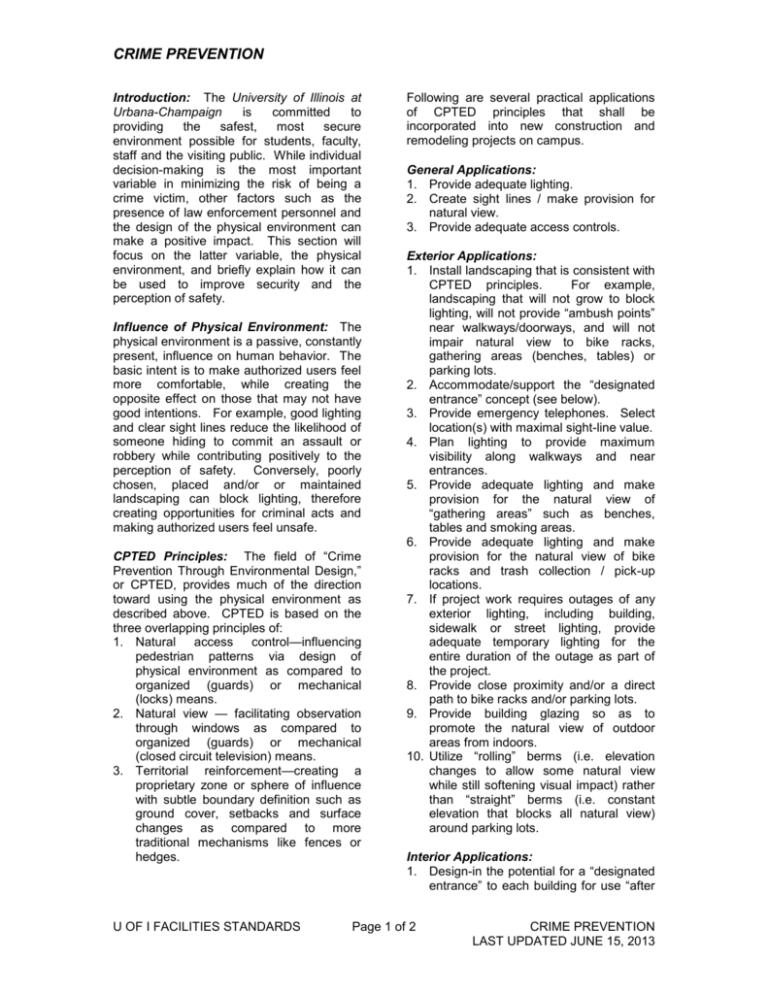Crime Prevention - University of Illinois at Urbana
advertisement

CRIME PREVENTION Introduction: The University of Illinois at Urbana-Champaign is committed to providing the safest, most secure environment possible for students, faculty, staff and the visiting public. While individual decision-making is the most important variable in minimizing the risk of being a crime victim, other factors such as the presence of law enforcement personnel and the design of the physical environment can make a positive impact. This section will focus on the latter variable, the physical environment, and briefly explain how it can be used to improve security and the perception of safety. Influence of Physical Environment: The physical environment is a passive, constantly present, influence on human behavior. The basic intent is to make authorized users feel more comfortable, while creating the opposite effect on those that may not have good intentions. For example, good lighting and clear sight lines reduce the likelihood of someone hiding to commit an assault or robbery while contributing positively to the perception of safety. Conversely, poorly chosen, placed and/or or maintained landscaping can block lighting, therefore creating opportunities for criminal acts and making authorized users feel unsafe. CPTED Principles: The field of “Crime Prevention Through Environmental Design,” or CPTED, provides much of the direction toward using the physical environment as described above. CPTED is based on the three overlapping principles of: 1. Natural access control—influencing pedestrian patterns via design of physical environment as compared to organized (guards) or mechanical (locks) means. 2. Natural view — facilitating observation through windows as compared to organized (guards) or mechanical (closed circuit television) means. 3. Territorial reinforcement—creating a proprietary zone or sphere of influence with subtle boundary definition such as ground cover, setbacks and surface changes as compared to more traditional mechanisms like fences or hedges. U OF I FACILITIES STANDARDS Following are several practical applications of CPTED principles that shall be incorporated into new construction and remodeling projects on campus. General Applications: 1. Provide adequate lighting. 2. Create sight lines / make provision for natural view. 3. Provide adequate access controls. Exterior Applications: 1. Install landscaping that is consistent with CPTED principles. For example, landscaping that will not grow to block lighting, will not provide “ambush points” near walkways/doorways, and will not impair natural view to bike racks, gathering areas (benches, tables) or parking lots. 2. Accommodate/support the “designated entrance” concept (see below). 3. Provide emergency telephones. Select location(s) with maximal sight-line value. 4. Plan lighting to provide maximum visibility along walkways and near entrances. 5. Provide adequate lighting and make provision for the natural view of “gathering areas” such as benches, tables and smoking areas. 6. Provide adequate lighting and make provision for the natural view of bike racks and trash collection / pick-up locations. 7. If project work requires outages of any exterior lighting, including building, sidewalk or street lighting, provide adequate temporary lighting for the entire duration of the outage as part of the project. 8. Provide close proximity and/or a direct path to bike racks and/or parking lots. 9. Provide building glazing so as to promote the natural view of outdoor areas from indoors. 10. Utilize “rolling” berms (i.e. elevation changes to allow some natural view while still softening visual impact) rather than “straight” berms (i.e. constant elevation that blocks all natural view) around parking lots. Interior Applications: 1. Design-in the potential for a “designated entrance” to each building for use “after Page 1 of 2 CRIME PREVENTION LAST UPDATED JUNE 15, 2013 CRIME PREVENTION 2. 3. 4. 5. 6. 7. 8. 9. 10. 11. 12. 13. hours” by all users without key/card access privileges. Locate “after hours” spaces (e.g. libraries, labs, etc.) in a manner that allows the rest of the building to be secured. Location of such spaces on the first floor, in a corner of the building, and/or providing them with a dedicated entrance is recommended. Locate restrooms and vending areas in low risk places, not at the far end of dead-end hallways and/or in isolated, poorly lit areas with little or no natural view. Make provision for the natural view of high-risk areas such as vending areas, restrooms, elevators, laundries, phone booths, etc. Avoid/eliminate vestibule-type entrances to restrooms. Use a maze design approach instead. Locate elevators, telephones, etc. so as to minimize foot traffic through each building. Locate light switches at the ends of hallways rather than the middle. Avoid/reduce blind corners in hallways by changing angles and/or installing mirrors. Provide adequate access controls. Utilize electronic door access systems at building entrance(s) as well as at doors that provide access to selected interior areas (see Door Access Control below). Make provision for the secure storage of valuables (e.g. provide lockable cabinets, etc). Install panic hardware with audible alarms on doors leading outside the building from classrooms that are not going to be locked (if valuables might be present). Utilize IP based security cameras (see Security Cameras below). Install the infrastructure required for IP based security cameras even if these systems are not planned for immediate installation. Lighting Systems: See the Lighting, Interior and Emergency and Lighting, Exterior sections within the General Guidelines. Security Cameras: Security cameras are not required on campus. However they are strongly recommended in public areas, at entrances/exits to buildings, and in areas containing highly valuable items, such as computer labs, museums, rare book rooms, retail stores, etc. Unmonitored security cameras are for deterrent/investigative purposes only, not personal security. Security cameras should be monitored in order to be used for personal security, and should not be used for this purpose if not monitored. Use of cameras for this purpose is recommended in areas such as underground parking structures or isolated/remote work sights. Intrusion Detection: Standards are being developed for intrusion detection hardware and software. Please contact the Department of Public Safety for more information. Additional Information: It would be impossible to offer every conceivable application of CPTED or provide guidance for all potential design questions in any document. Therefore, representatives from the Division of Public Safety should be utilized as a resource in the delivery of projects on campus. Questions about this Crime Prevention section should be directed to the University Campus Risk Manager or a University Police Crime Prevention Coordinator. Locks / Keying Systems: See the Locks / Keying Systems section within the General Guidelines. Door Access Control: See the Door Access Control, Electronic section within the General Guidelines. U OF I FACILITIES STANDARDS Page 2 of 2 CRIME PREVENTION LAST UPDATED JUNE 15, 2013











